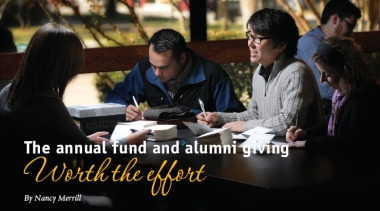 |
| Students express gratitude to donors at a Dallas Theological Seminary "thank-a-thon." |
Ask seminary development officers about the contributions that former students make to their institutions. Three areas of support will likely top the list: ✓Recruitment. Graduates of the institution are good at encouraging potential students to consider attending the seminary.✓Giving. Many graduates give, but usually not large sums. ✓Friend-sharing. A few rare gems encourage their well-to-do friends and colleagues to get excited about the school.
The conventional wisdom suggests that seminary graduates — a significant percentage of whom serve in pastoral ministry with modest salaries — may have the will but not the means to be major financial supporters of their alma maters.
But not everyone agrees. "My experience says ‘no' to the conventional wisdom," says David Heetland, vice president for development at Garrett-Evangelical Theological Seminary in Evanston, Illinois. "Alums can be very generous donors. The fifth-largest donor to our recent multimillion-dollar campaign is an alumnus."
Moreover, most alumni have family members, and some of them can become significant donors too.
For example, Heetland describes a call he received from a man whose parents had both attended the seminary. His father had received an M.Div. and his mother a degree in Christian education, and he wanted to visit the school, which he had never seen. During his time on campus, he told Heetland that he wanted to honor his parents by making a gift. His contribution of $1.2 million later funded three leadership scholarships.
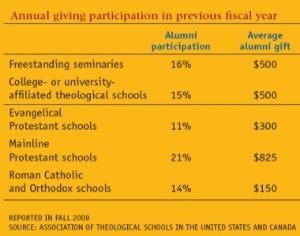 Another example: The husband of a second-career student became increasingly aware of student financial need while his wife was attending. On her graduation, he founded a student scholarship in her name.
Another example: The husband of a second-career student became increasingly aware of student financial need while his wife was attending. On her graduation, he founded a student scholarship in her name.
A third case: On the occasion of Garrett's 150th anniversary in 2003, the seminary hosted informational gatherings around the country to share the seminary's unfolding story and vision for the future. An Iowa alumni couple contacted Heetland a month after attending one of the meetings. They had made the decision to leave their farm to the seminary.
So yes, alumni and their family members can be generous.
Cultivating clergy connections
If there's any group that does not have the funds to give generously, it must be Catholic priests. Right?
Not so, says David Osborne, director of development at Saint Charles Borromeo Seminary in Wynnewood, Pennsylvania.
"We try not to presume about anyone's ability to give or ever consider whether someone is —or is not — being generous," Osborne says. "Our priest alumni did not go into ministry for the money, of course. The average priest will make only about $20,000 when he is first starting out. Nevertheless, our priest alumni have a long and proud history of giving financial support to their alma mater."
He says that over the last 10 years, 732 priest alumni have given more than $2 million — on average, that's more than $200,000 per year for the seminary's bottom line.
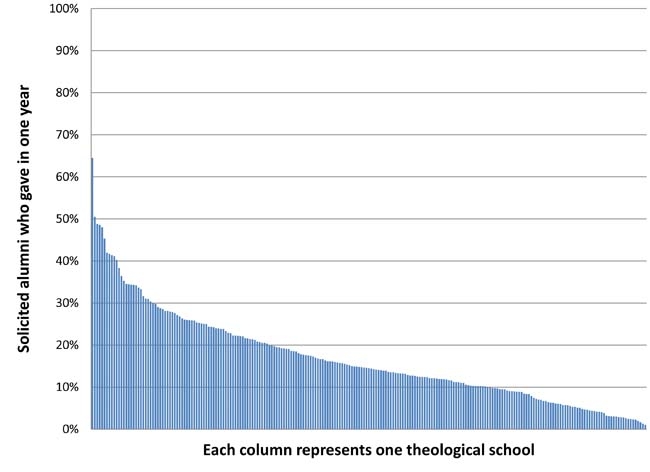 |
REPORTED IN FALL 2009
SOURCE: ASSOCIATION OF THEOLOGICAL SCHOOLS IN THE UNITED STATES AND CANADA |
Osborne offers a reminder that "alumni giving" means more than merely "small annual gifts." "Some priest alumni will be in a different financial situation later in their lives," he says, as the beneficiaries of inheritances or other gifts. That's why it's important to continue informing all alumni about the seminary's needs and about giving opportunities — ways in which they can express their gratitude to God.
Every year, North American seminaries submit giving data to the Association of Theological Schools. According to the submitted data, Lutheran Theological Seminary in Saskatoon, Saskatchewan, enjoys the highest alumni giving rate — in the most recently reported year, 64 percent of former students who were solicited ended up contributing.
"We work hard to get our alumni and new friends on the campus to keep them connected and informed," says Pamela Giles, the seminary's director of advancement. "The school hosts a study conference each spring and several special events during the year." Through the school's "Seminary on the Road" program, students and faculty members join the president on a three-day trip each year, visiting a Lutheran congregation to conduct an educational program for local pastors and community members.
"I believe alums are hugely beneficial to our schools," says Giles, "because of the connections they bring, future connections that will come, and their potential to influence congregations and other pastors to support our seminaries." She reports that among the school's largest donors was a couple introduced to the seminary by their pastor, who, when they joined his congregation, warned them that he would expect them to be generous givers to benevolence causes.
Gradually building generosity
Most seminaries solicit their graduates through a yearly appeal, usually called the "annual fund." But the annual fund targets other individual donors as well.
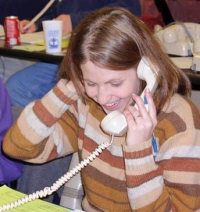 |
| Student caller at Duke University Divinity School phonathon |
At Duke University Divinity School in Durham, North Carolina, when you combine the gifts to the annual fund from former students and other friends and supporters, the sum is still less than 5 percent of the total money raised each year. But Wesley Brown, associate dean for external relations, is adamant about the importance of annual giving.
"Our annual fund dollars are almost entirely unrestricted and go directly to student financial aid," Brown says. Since major donors are increasingly inclined to give for specific purposes, Brown argues that the unrestricted annual fund dollars are more precious than ever.
What's more, these annual gifts are the seedbed for larger gifts to come. "We build important relationships in our annual giving program, consistently year after year, keeping people informed, thanking them promptly," says Brown. "It's important to have lots of people who care about the institution. The annual fund is the base from which interesting things can happen."
What kind of interesting things? David Heetland of Garrett-Evangelical provides an example: "A friend was introduced to our seminary in the mid-80s and was invited to make a gift," Heetland explains.
"He made a gift of $5,000. When the seminary launched a capital campaign a few years later, he made a $25,000 commitment. When a second campaign was launched 10 years later, he made a $250,000 commitment. When we launched our third campaign in 2003, he made a multimillion-dollar commitment."
A multimillion-dollar gift did not come on the first ask. "It came after 25 years of thanking him for his smaller gifts," Heetland says, "and letting him know the good that was being accomplished because of them."
David Osborne of Saint Charles Borromeo Seminary agrees. "Through an organization's annual appeal, the donor begins to build up a charitable habit," he says. "Donors who frequently give to annual appeals tend to also give to capital campaigns. Donors who frequently give to capital campaigns tend to make planned gifts through their estate planning. A donor's planned gift may be worth more than the total of all the other gifts she makes throughout her lifetime."
The gradual build-up of generosity, trust, and gratitude is what results in the larger gifts that really move an institution forward, says Heetland. "That is why we are committed to cultivating, soliciting, and stewarding smaller gifts from alums, friends, and churches, even if it is labor intensive - and it is," he says.
"Don't expect miracles, but do expect results over time if you have a well-organized development program," offers Heetland. The annual fund is an effective way to build relationships over time — deliberately, consistently, communicating the school's mission and vision to graduates and friends. The annual fund sows the seed for harvests to come.
Students learning to ask, give, and thank
"The annual fund provides a teaching opportunity for educating and forming students in the connection between giving and gratitude for what they received," says Betsy Poole, associate director of annual giving and alumni programs at Duke Divinity School.
 |
| At Duke, students "give something in return" by taking part in the phonathon, which brings in essential unrestricted funds. |
Wesley Brown, her colleague at Duke, elaborates: "With tuition discounted by half, I often tell graduating students that they received from this place so much more than they paid for," he says. "It's a privilege to be able to give something in return." The message is taking hold; in the past several years, the senior class gift has been directed to the annual fund.
At Garrett-Evangelical Theological Seminary, building a charitable habit begins as graduating seniors are asked to make a five-year pledge to the school — a considerable challenge for students who may be graduating with significant debt already.
"We try to help the new graduates find ways of giving that make it a little easier for them — like making a small contribution monthly, rather than a one-time gift," says Kay Burlingham, director of alumni relations and annual giving.
Students at Garrett also experience the challenge of fundraising first hand as volunteers at the annual student phone-a-thon. "It's important for students to gain experience in asking for money — something they'll be expected to do throughout their ministry careers — and to experience refusals as well as successes," says Burlingham. "Our phone-a-thon also involves ‘greeting and care' as students are asked to extend pastoral care as well as asking for a gift."
Schools like Duke and Dallas Theological Seminary conduct "thank-a-thons," where students gather to pen handwritten notes to donors, thanking them personally for their support of the seminary. At Dallas, scholarship recipients also send personal letters of appreciation to those who provide their scholarships.
Advocates on the board
The development committee of a theological school board is rarely overpopulated. Trustees are generally more comfortable as advocates and ambassadors for their schools than they are as fundraisers. Trustees can, however, contribute to the development effort by taking seriously the task of introducing new friends to the school. The peer-to-peer contact opens the door for the development staff to follow up with a donor at the appropriate time and for the appropriate opportunity.
"Trustees know people who share their interests and values, and it can be tremendously helpful to the development office when they introduce these people to the seminary," says David Heetland, the development chief at Garrett-Evangelical Theological Seminary in Evanston, Illinois.
Board members can invite friends to events like lectures, worship, or concerts. Elizabeth Visconage, vice president for advancement at St. Mary's Seminary & University in Baltimore, recalls one persistent board member who diligently invited a friend to visit the school. They ultimately attended morning prayer together from time to time, and the new friend later agreed to serve on a board committee.
Schools need a network of relationship-builders, starting with the president and the board. The advancement staff alone cannot build all the relationships that are needed. "Board members have connections we don't have," says Pamela Giles, the development officer at Lutheran Theological Seminary in Saskatoon, Saskatchewan. "They can be very helpful as positive spokespersons in the community. Trustees can be sharp critics in meetings, but they need to be effusive supporters in the community."
Case studies in giving
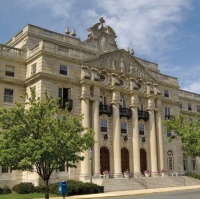 At St. Mary's Seminary & University in Baltimore, more than half of all donors are graduates of the seminary. Elizabeth Visconage, vice president for advancement and human resources, considers the annual fund essential — "not just for the dollars but for the connections we maintain through the annual appeal."
At St. Mary's Seminary & University in Baltimore, more than half of all donors are graduates of the seminary. Elizabeth Visconage, vice president for advancement and human resources, considers the annual fund essential — "not just for the dollars but for the connections we maintain through the annual appeal."
Visconage chairs the Development and Institutional Advancement Program (DIAP), the organization of development officers within the Association of Theological Schools. She says that the annual appeal is beneficial in at least three ways: It keeps all the school's constituents aware of what's happening on campus, raises unrestricted funds, and sometimes results in sweet surprises.
"Seminary development officers can sometimes feel like they are running just to stay in place," she says. "And then the wonderful surprise comes along, like when we learned that one of our alumni — a person who had not made a donation to our school during his lifetime — had left us his house on the New Jersey shore."
That translated into a $300,000 gift to St. Mary's. "Without the ongoing communication for the annual fund, that gift probably would not have come to us," Visconage says.
Dallas Theological Seminary raises its budget annually and operates without an endowment. "Most alums want to give something 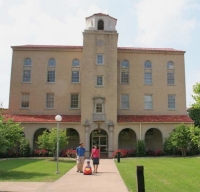 back," says Kim Till, vice president for advancement. "Where they contribute the most is probably in referring students to the seminary."
back," says Kim Till, vice president for advancement. "Where they contribute the most is probably in referring students to the seminary."
Second-career students at Dallas come from a range of business and professional careers, and sometimes they return to those careers. That means that not all graduates are modestly paid ministers. "One of our top five donors is an alumnus and businessman," Till says.
Gifts from major donors, whether alumni or friends, provide the largest return for the development office's time and resource. Their gifts make up a significant part of the $7 million that the Texas seminary raises each year.
 Gary Hoag was vice president of advancement at Denver Seminary from 2002 to 2009. During those years, he coordinated the campaign to build a new seminary campus in the Denver suburb of Littleton, Colorado. Now, as a development consultant, he reports that annual appeal results usually spike when the effort is either a percentage or project appeal.
Gary Hoag was vice president of advancement at Denver Seminary from 2002 to 2009. During those years, he coordinated the campaign to build a new seminary campus in the Denver suburb of Littleton, Colorado. Now, as a development consultant, he reports that annual appeal results usually spike when the effort is either a percentage or project appeal.
"Percentage campaigns focus on participation, and a gift in any amount counts toward the goal of 100 percent participation," he says, noting that each person can give according to his or her means, following the admonition of 2 Corinthians 8. "Schools are often pleasantly surprised with the results of this approach. There's no favoritism in a percentage appeal; everyone is invited to help and everyone is needed to reach the goal."
On the other hand, project appeals work best when givers can identify with the project — like new student facilities. "While I was at Denver Seminary, we called the annual fund the ‘seminary fund,'" he says. "All gifts were allocated to student scholarships and faculty salaries."
Development strategies
David Osborne, director of development at Saint Charles Borromeo Seminary, says not to treat all donors the same
What do you think of events?
I find that "event fundraising" is inefficient for producing revenue, but I know that some organizations are very successful with events. Most events that I have seen have only produced three to four times as much as they cost - not including intangible resources such as labor. On the other hand, an annual appeal may produce 10 times as much as it costs. A capital campaign may bring in 100 times as much as it costs. And planned giving can bring in 1,000 times as much as it costs.
Why do you still conduct fundraising events?
Events produce more than revenue; they deepen donor relationships. I would rather run events to produce friends and deepen relationships than to try to create a dependable revenue source. One donor appreciation event that my staff and I ran was a reception for about 500 donors. It was not designed to make revenue, and we did not break even that night. At the event, we thanked the donors for their annual appeal giving and educated them on the use of those funds. The attendees were tracked over the next year, and their annual giving went up an average of 30 percent. The next year, we increased the invitation list and ran the same event for about 800 donors.
 |
| Alumni Jubilee Mass at Saint Charles Borromeo Seminary. Cardinal Justin Rigali, archbishop of Philadelphia, is the primary celebrant at the altar. |
What are your strategies?
Boards need to understand the sources of fundraising revenue. Donations come from two sources: income and assets. Both income and asset wealth are concentrated. In the United States, the top 1 percent of income-earners garner almost 20 percent of all annual income, and the top 25 percent earn almost 70 percent of all annual income.
Meanwhile, 80 percent of the asset wealth in the country is controlled by those ages 65 or older - and they only hold about 9 percent of their wealth in cash. A lot of organizations make the mistake of expending all of their fundraising efforts on the operational or annual fund - perhaps only doing direct mail, which attracts disposable income and treats all donors and prospects the same.
But the fundraising strategy needs to match the type of wealth it is pursuing and the type of people that have excess wealth. An individual's constitution ought to be different when deliberating on giving $10 versus $100,000. If top wage earners or asset holders are expected to give in proportion to the amount they own, then an organization needs to commit to fundraising activity that acknowledges how these individuals are different and how their giving decisions are different. Also, organizations need to educate their donors on giving other assets - in addition to cash.